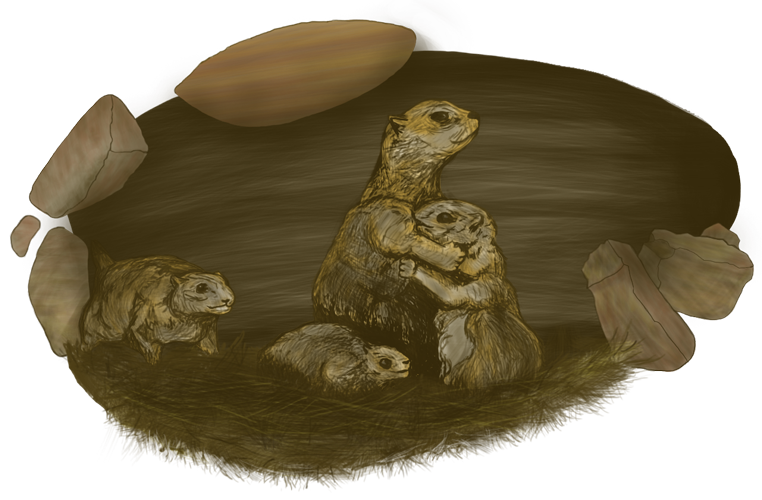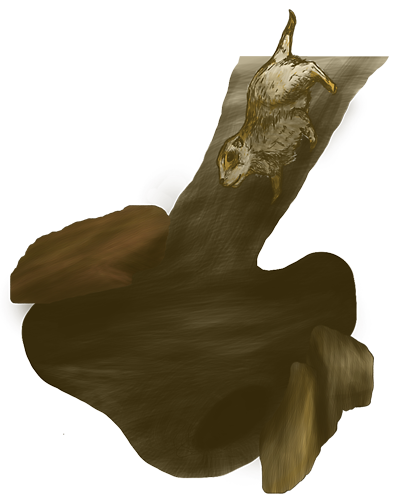Research
2008 Translocation with Post Release Survival Study

In the summer of 2008, 195 Gunnison’s prairie dogs were translocated from areas in Flagstaff, AZ that were slated to be poisoned or developed. Habitat Harmony, Inc. in conjunction with Northern Arizona University and financial support from an Arizona Game and Fish Department Heritage Grant used this translocation opportunity to help research the one-year post release survival success and different release techniques for Gunnison’s prairie dogs. We hope this research will aid our understanding of successful translocations for prairie dogs in need of new homes in the future.
Special thanks go to all the amazing volunteers and field technicians and interns that assisted with trapping and observations of the prairie dogs in 2008 and 2009! Thank You.
During the summer of 2009, we attempted to re-trap and identify all the translocated survivors and their pups. Through observations, re-trapping, a PIT tag scanner deployed at the burrow openings, and remote cameras, we identified a total of 63 tagged translocated adult prairie dogs and 84 pups for a total estimated population of 147 prairie dogs one year after the translocation. Furthermore, the prairie dogs dug hundreds of new holes and spread out into the grassland surrounding the release area. An unfortunate discovery of our research is witnessing and documenting the toll human hunting and target shooting may take on prairie dog survival. We recommend additional management actions to limit hunting and protect newly translocated colonies. Our research shows that translocations of prairie dogs can, in fact, provide a valuable conservation tool for rescuing displaced prairie dogs and re-establishing abandoned colonies for a Species of Greatest Conservation Need.
Click here to download a pdf of "Translocation of Gunnison’s Prairie Dogs From an Urban and Suburban Colony to Abandoned Wildland Colonies" by Emily Nelson and Tad Theimer. This Article was printed in the Journal of Wildlife Management.
Click the read more link below to see pictures and learn more about the translocation project.
Venomous Reptile Translocation Studies
 Translocation of Urban Gila Monsters: A Problematic Conservation Tool
Translocation of Urban Gila Monsters: A Problematic Conservation Tool
The Gila Monster (Heloderma suspectum) is a large, venomous lizard protected throughout its distribution in the southwestern United States and northwestern Mexico. Rapid urban growth in key areas of its range and increased encounters with humans prompted us to investigate translocation as a conservation tool with ‘‘nuisance’’ Gila Monsters. Twenty-five Gila Monsters repor- ted as nuisances by residents in the northeastern Phoenix Metropolitan Area were translocated from 0 to 25,000 m from their point of capture. Subjects (N=18) translocated less than 1000 m returned to their original site of capture within 2–30 days; none of those (N=7) translocated more than 1000 m successfully returned, they exhibited high daily rates of speed, and were deprived the use of familiar refuges. We conclude that small distance translocations within suitable habitats are ineffective in removing Gila Monsters from areas deemed unsuitable. Moreover, individuals moved significantly greater distances are unlikely to remain at a translocation site, and may experience a variety of costs (e.g., predation risk) associated with high rates of movement.
# 2003 Elsevier Ltd. All rights reserved.
Management of "Nuisance" Vipers: Effects of Translocation on Western Diamondback Rattlesnakes
by Erika M. Nowak, Trevor Hare, and Jude McNalley
Wildlife Reference Guide
- Created by Habitat Harmony & AZ Game & Fish
- Covers wildlife relevant topics in nine Flagstaff area plans
- Used in Flagstaff’s new Land Development Code
- Submitted for use in revision of Flagstaff’s Regional Plan
- Summary requested by Flagstaff City Councilman

Habitat Harmony recognized the need to coordinate the massive amount of information in the many plans for wildlife in the Flagstaff area. Habitat Harmony partnered with AZ Game & Fish to employ NAU graduate student to write the Wildlife Reference Guide to coordinate the information on wildlife and habitat in nine area plans. At the request of a Flagstaff City Council member, a Summary of the Wildlife Reference Guidewas written to provide the key planning information in a more user-friendly format.

Click here for Summary of Wildlife Reference Guide
Click here for full version of Wildlife Reference Guide
Photo by: Nathan Renn
Capture and Release Research Report

by Chris Campbell - all rights reserved. No reuse without permission of the author.
INTRODUCTION
Habitat Harmony, Inc. (“Habitat”) was formed in the year 2000 with the goals of protecting wildlife and wildlife habitat in northern Arizona as well as educating the public on wildlife issues. To that end we have worked in cooperation with the Arizona Department of Game and Fish (“Game and Fish”) on several projects, relocating Gunnison’s prairie dogs. In the summer of 2003, as part of our relocation project at the Flagstaff Mall expansion site, we moved prairie dogs to the Raymond Wildlife Area, using augured holes for the first time. Due to the scarcity of abandoned prairie dog colonies that are approved for Gunnison’s prairie dog relocation, Game and Fish requested that Habitat research the technique of auguring.
During the research for this report, it became apparent that most groups that are active in relocation work do not use auguring alone as a release technique. For this reason, the research was expanded to include other release techniques that involve moving prairie dogs to areas other than abandoned colonies, as well as capture techniques. The following topics may be as useful to future relocation projects as auguring, and are included in this research report:
Wildlife Corridors in the Flagstaff Region

As the human population grows in the Flagstaff region, we increase the impact of transportation corridors (such as roads and rails) and land use changes (such as urban and rural development) on wildlife populations. The frequent result of these activities is habitat fragmentation, which creates barriers to animal movement within previously unfragmented blocks of habitat. Promoting wildlife habitat connectivity will help:
- improve human safety by reducing vehicular collisions with wildlife;
- maintain the ability of animals to access necessary resources for survival and reproduction;
- allow for wildlife movement between populations;
- allow for seasonal migration;
- enable population movements in response to climate change;
- and prevent genetic isolation of wildlife populations.
A Message to Humans

"I used to be a city fellow. I grew up with the city noises of cars and trains and machines and humans. My family lived close to downtown Flagstaff not far from the railroad tracks along Route 66. What a busy, frightening place it was."
Read My Letter to You












